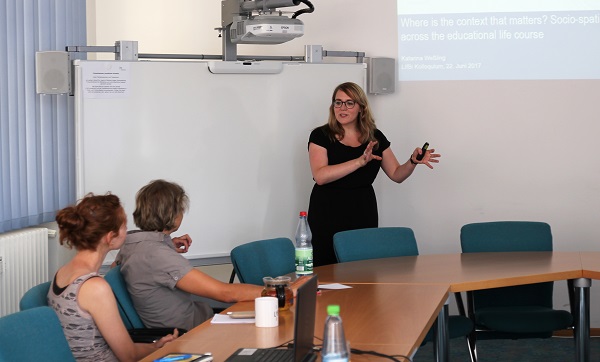Dr. Katarina Weßling, University of Cologne, talks about the relations between context characteristics and transitions to secondary education, vocational training, higher education, and the labor market.

Dr. Katarina Weßling talks about context effects at educational transitions at the Leibniz Institute for Educational Trajectories (LIfBi).
In her guest lecture, Katarina Weßling first outlined the theoretical and empirical significance of different levels of context(s) in relation to different questions. Specifically, she operationalized “context” in her analysis in terms of the varying radial distances that exist between an individual and his or her surrounding administrative districts (of first and second order) and cities, for example. The unemployment rates and percentages of students varying between these areas or radii were implemented in the calculations as characteristics of the living and decision-making context.
In her analyses, Katarina Weßling used retrospective survey data of Starting Cohort 6 (adults aged up to 65 years) of the National Educational Panel Study (NEPS) in combination with data of the Federal Institute for Research on Building, Urban Affairs, and Spatial Development; the German Federal Statistical Office; the Federal Employment Agency; and the Federal Agency for Cartography and Geodesy. With these data she was able to show that context characteristics, such as the percentage of students or of unemployed persons, have a significant positive correlation with the transition to Gymnasium (type of school leading to upper secondary education and Abitur) and higher education.
The visibility of these effects depended however on the radial distance of the context characteristics in relation to the individual. The daily perceivable and accessible spatial context (and its characteristics) were primarily relevant to the individual. Adverse opportunity structures and preference cluster in the near distance could be compensated by more favorable characteristics in the farer distance, so the assumption of Katarina Weßling. She substantiated her assumptions, for example, with an analysis of Dutch survey data on educational behavior and labor market entrance.